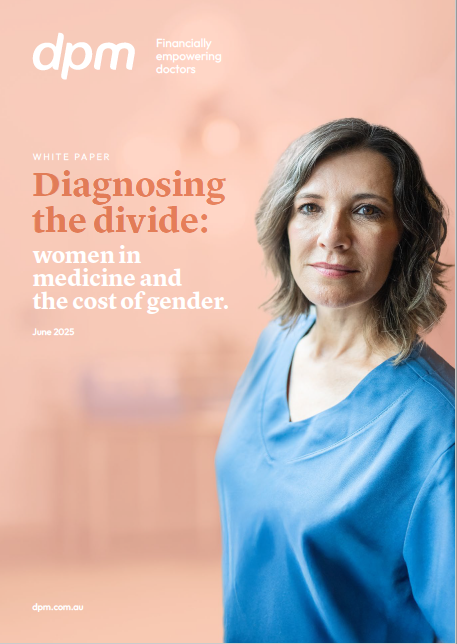DPM WHITE PAPER
Diagnosing the divide: women in medicine and the cost of gender
An Analysis of Financial Disparities Facing Women in Medicine
Despite significant progress in medical education, with women now comprising 53% of graduates, substantial financial disparities persist throughout female doctors’ careers. Our comprehensive analysis of Australian taxation data and the MABEL longitudinal study reveals the complex realities facing women in medicine today.
What our research reveals
Female doctors earn a median income of $219,327 compared to $386,011 for male colleagues, a $167,000 annual gap that extends across virtually every medical speciality. This disparity isn’t simply explained by working hours; even when controlling for part-time work, significant gaps remain.
The motherhood penalty compounds these challenges, with women’s earnings dropping 55% in the first five years after having children. Systemic barriers including unconscious bias, limited flexible training pathways, and career timing pressures create ongoing obstacles that individual effort alone cannot overcome.
Addressing the Challenge
While this research highlights practical strategies female doctors can implement, from proactive superannuation planning to building supportive networks, it fundamentally demonstrates that achieving true equity requires systemic change within healthcare institutions, training programs, and workplace cultures.
This white paper provides female medical professionals with both the data to understand these realities and evidence-based approaches to navigate them, while contributing to the broader conversation about structural reform needed in Australian medicine.
Download the complete white paper to discover evidence-based strategies that can help you navigate these challenges and optimise your earning potential throughout your medical career.

Download Now
Frequently asked questions
Female doctors earn a median of $219,327 compared to male doctors at $386,011 – that’s a $167,000 gap on annual taxable income. This disparity exists across virtually all medical specialties, with male doctors consistently earning more, ranging from an 11% gap for Medical Officers to 79% for Pathologists. The gap persists even when looking at hourly rates, suggesting it’s not simply about working hours.
Yes, significantly. According to Australian Treasury analysis, a woman’s earnings fall by an average of 55% in the first five years after having children, and this gap continues for years. The research shows that female doctors with children consistently earn less than their male counterparts across all three major specialty groups (GPs, Surgery, and Non-GP Non-Surgical Specialties), even when comparing hourly rates rather than just annual income.
Surgery remains the most male-dominated specialty with only 16% female representation. Pathologists show the largest income gap at 79%, while Diagnostic Radiologists face a 69% disparity. Even in specialties with more women, significant gaps persist – female GPs still earn 24% less than their male counterparts.
Research shows that female doctors may be more hesitant to set high fees due to concerns about patient affordability or societal expectations. Some report feeling that patients might not accept the same fee levels from them compared to male colleagues. Additionally, fewer female doctors transition to 100% private practice, with many preferring the stability of public hospital positions, especially during child-rearing years.
Start with proactive superannuation planning – women live 4 years longer than men but retire with lower balances. Consider “catch-up” contributions if your balance is under $500k. Get quality financial advice early in your career, build supportive professional networks, and understand that income protection insurance costs 32% more for women so factor this into your planning.
Want to share this research with your team or colleagues?
If you’d like someone from DPM to present these findings to your medical group, hospital department, or professional association, we’d be happy to help. Our team can tailor the presentation to your audience and discuss the specific financial strategies that matter most to your colleagues.
Just email our marketing manager, Kim Robbins [kim.robbins@dpm.com.au] to set something up. We’re excited to start sharing this research more widely and know these presentations lead to great discussions about the real financial challenges women in medicine face.
Ready to turn insights into action?
The strategies in this white paper provide a powerful foundation, but the true value comes from tailoring them to your unique financial situation.
If you’d like to chat with a DPM consultant about your individual circumstances, click here to book an appointment.

